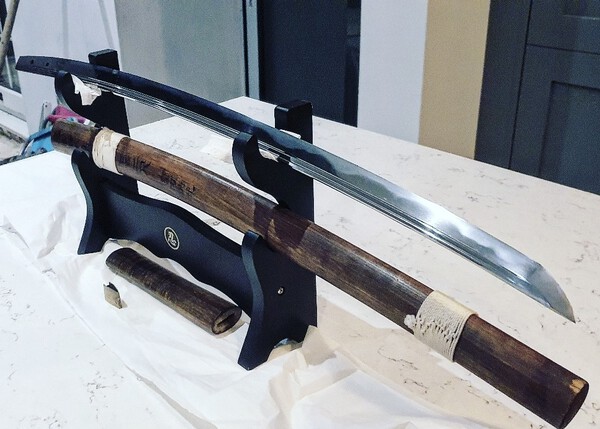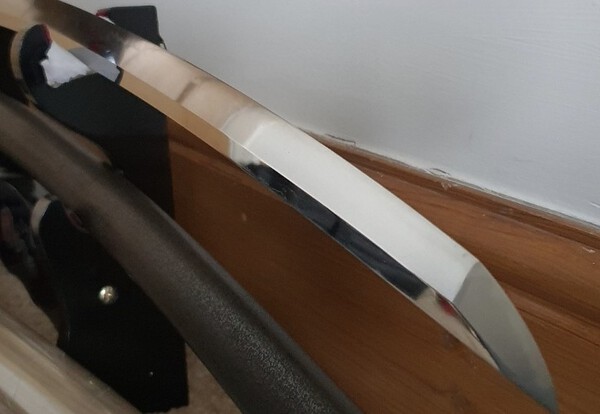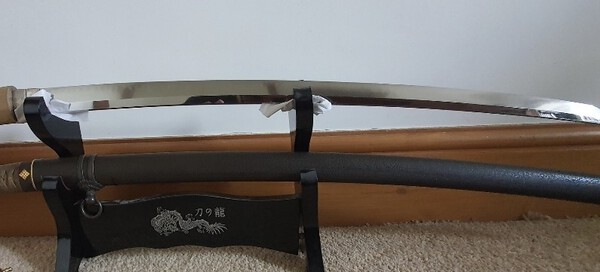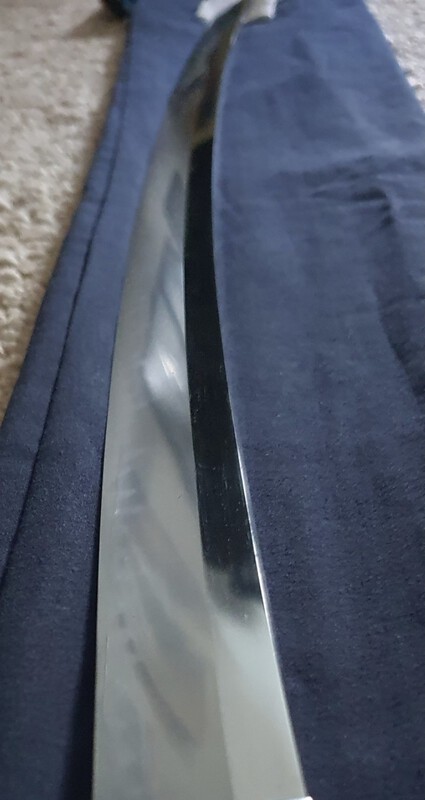
Paz
Members-
Posts
411 -
Joined
-
Last visited
-
Days Won
1
Content Type
Profiles
Forums
Events
Store
Downloads
Gallery
Everything posted by Paz
-
Looking to buy my first traditionally made katana
Paz replied to Ledheadforlife's topic in Wanted to Buy
If you want to know it cost me 450 bucks on books. Yep. They are absolutely required in this hobby par none. -
Hi all, thought I'd post this new pick up. Ujisada late muromachi blade. Mino soshu and apparently one of the favourite smiths of Hideyoshi Toyotomi. The blade is 60 cm shortend, and does need a polish which was reflected in the price. NBTHK hozon last year, and does have a neutralized rust spot. I purchased it because I liked the look of it and the hamon aswell. Doubt il ever have it polished as I don't really know anyone who is still active and can do a top job in the UK (as far as I am aware). Regards
-
So what's a weird deal-breaker for you?
Paz replied to Brian's topic in General Nihonto Related Discussion
Shinto blades which have no significance ie look great but never used or made for art. I'd take a damaged battlefield sword over a decorative showpiece. Signed blades with signatures. Which dumb militaria dealers have a hard on for even though the blade could be a piece of s**t ( mind my language). Lack of signature builds the air of mystery to the sword, and is funny when "experts" get it wrong. I'd rather have a mumei koto blade which was built for purpose and has beauty aswell. I don't care too much for polish. As original polish sometimes means the sword how it was, when it was being used. Ww2 guntos and gendaito. Just don't care for them and they don't attract me. So strictly speaking im hardcore koto, only 3 words catch my attention kamakura, nanbokucho, muromachi. Regards -
Why Kamakura = best swords ever??
Paz replied to Nicolas Maestre's topic in General Nihonto Related Discussion
This. OK I'm going to ask a stupid/question statement. And I don't care for looking stupid because I'm young and want to learn and that's why I joined. Smiths who were worked in the Nanbokucho era were trained by Kamakura smiths. Aswell Kamakura smiths who worked into the Nanbokucho era. How much of a difference could this actually be ?? These guys watched their "Kamakura " teachers and probably continued to forge In the same way, trying their best to replicate their works. The only difference I know is the size/length of blades changed later in Nanbokucho. So in fact why not stick Nanbokucho blades in with late Kamakura. I know the emperors changed. But were talking about smiths who lived and learnt with each other passed down in intensive environments. For example blades and smiths quality change in the muromachi era due to increase demand, that we can tell is a substantial changed in quality. Regards -
@FZ1 Wow. How's the project going Jon ? Have you managed to get a tsuka and saya made for your tachi ? Please do send photos once completed Regards
-
Why Kamakura = best swords ever??
Paz replied to Nicolas Maestre's topic in General Nihonto Related Discussion
Isn't that what I said ? Late kamakura. 🤔 -
Why Kamakura = best swords ever??
Paz replied to Nicolas Maestre's topic in General Nihonto Related Discussion
It also comes down to smiths and schools and who were around. You have the osafune and bizen schools ect. But by late kamakura early nanbokucho you have legends such as Masamune, shintogo kunimitsu, Norishige ect who work into the nanbokucho period. And their influence is heavy on their students. Blades are much more darker and have the highest quality jigane and hada. You have what is the combination of beauty art and a deadly weapon. The mass production of the sengoku jidai did have an effect on quality and artistic style of blades. But not necessarily functionality. The shinto period is considered on average the period where you have art swords as there was no need for top functionality. But this doesant mean all swords as formentioned were like this. Regards -
Regarding this Ian, I purchased a sword from USA and it arrived at Heathrow and then went onto Coventry parcel force Hub. What confused me is that it would it go through customs to get into the country first, before it got to the depot? But I only got sent the Arrival form c160 to complete this week. So would this mean that Heathrow cleared it into the country then Coventry parcelforce ask for the VAT customs completion. Was confused by this. As i thought Heathrow would clear it Regards
-
If anyone wishes to sell me this book or has a link to where it is sold at a humane price I'd be grateful. Amazon are selling it for over 1k 😆 and other sites are not letting this one go cheap. It is out of print so. But I also found Victor harris and Obusawara sword of the samurai book for 15 quid. What a bargain 👌 Regards
-
Nanbokucho Conflict casualties and Stats
Paz replied to Utopianarian's topic in General Nihonto Related Discussion
So I became very interested in this period of Japanese history owning to the fact that I own a nanbokucho blade from ko uda, which has kizu from another sword. My idea is that the blade I own was used during the nanbokucho and sengoku jidai. The battles of the nanbokucho were between two emperors, one supported by the muromachi shogun Takuji who eventually won and ruled. So these battles took place throughout 1333-1396. In the Kyoto, and Kamakura region? Which means most blades made between late kamakura after the Mongols during the time of smiths shintogo kunimitsu and masamune, were blades used in Nanbokucho battles until 1396. Which means most of these battles took place with cavalry warfare, mounted samurai with very long blades. And these blades were shortend in the muromachi period. Please correct me if I'm wrong, as I'm not as acquainted to this part of Japan's history. Thanks -
Was that ko uda or uda muromachi? The hada looks similar to my ko uda Let me guess they attributed it to Masamune 😏
-
Hi all. I've searched this forum and a few sites and books. The best result I got was from Paul Martins website samurai museum, which gave a good description. The Smith i want more info on is Gonoshosho Ujisada of Mino. Possibly part of the Zenjo school. One stand out story which attracted me to the blades was the association with Hideyoshi toyotomi, who favoured this school. Apart from that I can't really find much. What I understand is that he's a late muromachi period mino den Smith who made good battlefield weapons. Thanks Regards Paz
-
I still beleive these are not good or healthy for the market. If anything good for the modern collectors and production blades. But It's soo annoying to know that Chinese sword makers try so hard to replicate the Japanese nihonto, because they know it makes money. But this can easily fool the uneducated as these blades caught me out first time aswell. This is why I buy antique papered swords only. And avoid any modern blade unless its sold in Japan. Regards
-
Both Michael and Colin. I can't disagree with what Michael has written here. And he's on the mark when he talks about commercial aspects of this hobby. I can click on a website or send a message on FB to buy a sword. Or what I have been doing is dealing privately with UK members. The plus is that I can view a blade before I buy it. And I'm afraid to say that most of my generation in the UK, if interested in buying a sword are going to go over to a website and click on the button. And it is cringe how some of these people don't actually know what there buying. A young chap approached to buy one of swords when he saw them on photo, and he was told they were not for sale. He then goes and buys a stainless steel wallhanger and claimed he now had a samurai sword. A good majority of youngsters in the UK interested in swords, are just not likely to pick up books and learn the topic before they buy. Now if these youngsters or middle aged men, attended a show or event where they can learn something then yes. I'm currently dealing with young similar aged people in the USA who seem to possess alot of knowledge, and guess what, they attend events and shows constantly. They get to hold Juyo blades and study them on a monthly basis. I will be absolutely honest. I actually did not know that you could even get a nihonto at a reasonable price in the UK until last Christmas. I had been collecting modern Chinese replicas, because I thought I couldn't afford or do better. On my masters course at SOAS for example, no mention at all of Japanese millitaria and swords. There was more attention given to Japanese paintings as an entire course/ module. Regards Paz
-
I completely understand why they wouldn't sell certain stuff to Gaijin ie such as importance or keeping them in the country. In terms of knowledge alot of it is now translated into books. And I have to commend Paul martin and his work on translation and being a foreign sword expert. But I guess the elitism is prevalent in nearly everything, in most all hobbies be it art, to collecting stamps. Regards
-
Hi Jean yes I know that I was implying it looked shinshinto from first glance .
-
Nice blade Tony. Dare I say this isn't Shinshinto at all? It has more sori. Definitely not a kanbun era. I maybe wrong Regards
-
There is a way to avoid this. Especially with Chinese trying hard to replicate antique blades. Buy NBTHK papered. Until the Chinese find a way to replicate them too. Then we're truly f*****d
-
Riv can you elaborate please on this? I've dealt with few dealers from Japan who are happy to sell to foreigners. And there's also one youtube show in which the Japanese dealers are happy that foreigners are interested. The idea i get is that no Japanese youth are interested in nihonto its usually the older generation. In fact there is a video where they interview people in the streets of Tokyo mainly youngsters and none of them care or even know they are still made. One girl even said " why are people interested in these dangerous things" Plus the Japanese freinds I trained with also showed no interest in old swords. Like you were referring to. Regards
-
Sorry Michael I was referring to the laws around blades in general, which as you were saying earlier are inconsistent when it comes to law enforcement. With the current war on knife crime, I've met 2 people in car parks to view and buy blades. As we can't always take these indoors unless it's an event. I didnt mean to knock the efforts of the society and will hopefully be joining you in September aswell. Its just our freinds in the USA whom I've recently been speaking to have many more events. But that's probably because they have more swords in the U.S Regards Paz
-
Thanks Thomas I appreciate that. What baffled me about budo in general both iai and kendo was that people are happy to practice these arts. But not many bothered to research the history or understand the origins of the art. In my opinion the sword itself, study of the nihonto tells many different things about how warfare changed. And that in turn tells us how the martial arts changed. I do remember my sensei showing me his Japanese made shinken. But it was a modern made iai specific blade made from modern steel. Not actually a shinsakuto forged by a Smith. Which I was trying to ask him without being rude. But It's also true as my fellow British members said previously, that the UK isn't as accomodating as the US when it comes to vieweing and collecting swords. Regards Paz
-
Hi Ian and @paulb Your spot on when it comes to age. I'm considering that I'm the youngest member of the token society UK at 34. And I have met a couple of members for sword purchase who all are in their 60s. I've rarely come across someone in the UK who is under 40 and member of the token society actively. And it is a shame that we can't meet even though I can get to London in an hour and half. Other than that all we have are books and Internet to learn from , and then buying blades themselves. I was a member of the British kendo association, practiced both kendo and iaido. And from my experience not many practioners especially amongst the young are interested in nihonto. Maybe either because they believe their too expensive and difficult to obtain ( which is a point), or they don't care. Nobody in our numerous conversations would ever bring up the topic of militaria collection. I do feel lonely in my hobby for the lack of better words. But I have come up with my own solution. As I has a masters degree in Japanese studies, I thought I'd use that knowledge to do personal blogging on my own site and social media. What I plan to do, to get the interest of people is write my own articles around the history and culture of nihonto. What I notice is that people are more interested in historical information and cultural information , than basic when and how the blade is actually made, materials, types of hamon ect. So I'm trying to add as much history and culture to make each blade I talk about stand out. For example a blade by Terukado fujiwara, was also owned by kondo isami ect ect. I love to blend history and culture of its time to the blade. As I do believe each blade tells a story which an historian can take advantage of. Hopefully il get this site up and running soon. Regards Paz
-
Thanks Grey. Would re temper happen in order to remove faults and damage to the blade Thanks
-
Hi all, just for my own educational reasons I have a question regarding hamons. On my first blade which I adored but now have moved on, the hamon was not very prominent or showed up that well in comparison to other blades I owned. The sword was a late muromachi koto, and at the time I needed good lighting to see the hamon. Otherwise the hamon wasn't that prevalent. The blade was polished not that long ago. And I understand that polishing too much can lead to a less vibrant prominent hamon. Or sometimes it could poor workmanship during the process of hardening the edge. Now keep in mind the blade was made during the mass production of the sengoku jidai. Nevertheless I really liked the blade, and overlooked it. But for purpose of education and learning I'd like to know why. There maybe no problem at all I'm just curious. It could be the way it's polished. The hamon was a sanbunsugi. The blade was a mino den kanesaki senjuin with sashikomi polish. Thanks photos attached















